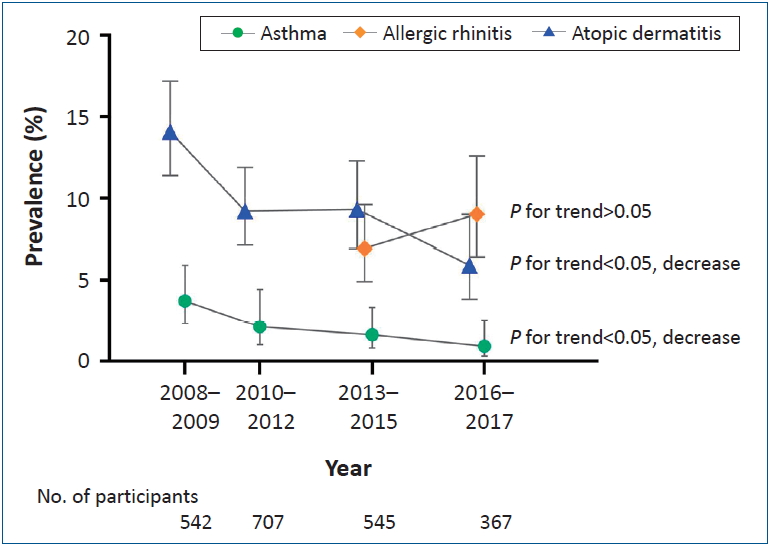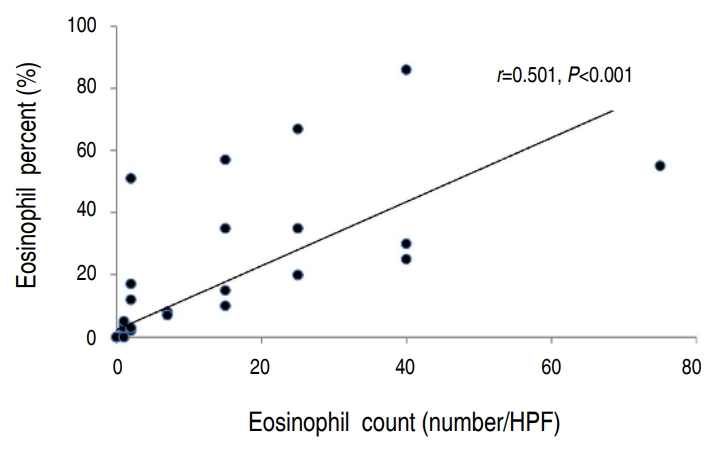Search
- Page Path
-
- HOME
- Search
- Review Article
- Allergy
- Prevalence, comorbidities, diagnosis, and treatment of nonallergic rhinitis: real-world comparison with allergic rhinitis
- Hye Yung Yum, Eun Kyo Ha, Yoon Ho Shin, Man Yong Han
- Clin Exp Pediatr. 2021;64(8):373-383. Published online August 10, 2020
-

Rhinitis is among the most common respiratory diseases in children. Nonallergic rhinitis, which involves nasal symptoms without evidence of systemic allergic inflammation or infection, is a heterogeneous entity with diverse manifestations and intensities. Nonallergic rhinitis accounts for 16%–89% of the chronic rhinitis cases, affecting 1%–50% (median 10%) of the total pediatric population. The clinical course of nonallergic rhinitis is generally...
- Original Article
- Allergy
- Ten-year trends and prevalence of asthma, allergic rhinitis, and atopic dermatitis among the Korean population, 2008–2017
- Jihyun Ha, Seung Won Lee, Dong Keon Yon
- Clin Exp Pediatr. 2020;63(7):278-283. Published online January 29, 2020
-

Background: Major questions remain regarding the agestratified trends of allergic diseases and asthma in Korea.
Purpose: To identify the estimated recent prevalence and 10- year trends in asthma, allergic rhinitis, and atopic dermatitis among the Korean population from 2008 to 2017. Methods: This nationwide cross-sectional survey (Korean National Health and Nutrition Examination Survey) over 10 years (2008–2017) examined representative samples of the...
- Nasal eosinophilia and eosinophil peroxidase in children and adolescents with rhinitis
- Yeonu Choi, Haeun Jeon, Eun Ae Yang, Jong-Seo Yoon, Hyun Hee Kim
- Clin Exp Pediatr. 2019;62(9):353-359. Published online April 24, 2019
-

Background: Researchers have shown that eosinophil peroxidase (EPO) is a relatively accurate marker of eosinophilia and eosinophil activity. However, its use as a marker of eosinophilic inflammation in nasal secretions is limited because the diagnostic cutoff values of EPO for use as a one-time test for allergic diseases such as allergic rhinitis have not been established.
Purpose: To identify the correlation...
- Review Article
- Allergy
- Impact of perinatal environmental tobacco smoke on the development of childhood allergic diseases
- Hyeon-Jong Yang
- Clin Exp Pediatr. 2016;59(8):319-327. Published online August 24, 2016
-
Allergic diseases such as asthma, allergic rhinitis, atopic dermatitis, and food allergy, are most common chronic, noncommunicable diseases in childhood. In the past few decades, the prevalence has increased abruptly worldwide. There are 2 possible explanations for the rising prevalence of allergic diseases worldwide, that an increased disease-awareness of physician, patient, or caregivers, and an abrupt exposure to unknown hazards....
- Original Article
- Allergy
- The relationships among birth season, sunlight exposure during infancy, and allergic disease
- Jung Min Hwang, Se Hyun Oh, Mee Yong Shin
- Clin Exp Pediatr. 2016;59(5):218-225. Published online May 31, 2016
-
Purpose The recent increase in the prevalence of allergic diseases is hypothetically attributed to immune dysregulation in turn caused by a reduction in exposure to sunlight. We explored relationships between birth season, sunlight exposure, exercise duration, and an allergic disease.
Methods We performed a questionnaire-based survey on allergic diseases among elementary school students. Birth time was categorized according to the season (summer and...
- Vitamin D serum levels in children with allergic and vasomotor rhinitis
- Seung Jin Lee, Bong Hwa Kang, Bong Seok Choi
- Clin Exp Pediatr. 2015;58(9):325-329. Published online September 21, 2015
-
Purpose In addition to regulating calcium and phosphorus homeostasis and bone metabolism, vitamin D is known as an immune modulator. Recently, there has been increased worldwide interest in the association between low levels of vitamin D and allergic diseases. The purpose of this study was to assess the relationship between serum vitamin D levels and allergic/vasomotor rhinitis (AR/VR) in children.
Methods This study...
- Prevalence and comorbidity of allergic diseases in preschool children
- Hyeong Yun Kim, Eun Byul Kwon, Ji Hyeon Baek, Youn Ho Shin, Hye Yung Yum, Hye Mi Jee, Jung Won Yoon, Man Yong Han
- Clin Exp Pediatr. 2013;56(8):338-342. Published online August 27, 2013
-
Purpose Allergic disease and its comorbidities significantly influence the quality of life. Although the comorbidities of allergic diseases are well described in adult populations, little is known about them in preschool children. In the present study, we aimed to assess the prevalence and comorbidity of allergic diseases in Korean preschool children.
Methods We conducted a cross-sectional study comprising 615 Korean children (age, 3...
- Comparison of air pollution and the prevalence of allergy-related diseases in Incheon and Jeju City
- Su Ho Jeong, Jeong Hee Kim, Byong Kwan Son, Seong Chul Hong, Su Young Kim, Geun Hwa Lee, Dae Hyun Lim
- Clin Exp Pediatr. 2011;54(12):501-506. Published online December 31, 2011
-
Purpose A high level of air pollutants can increase the number of patients with allergy-related diseases such as asthma and allergic rhinitis (AR). To analyze the association between air pollution and allergic disease, we investigated 2 areas in Korea: Incheon, an industrial area, and Jeju, a non-industrialized area.
Methods Second grade students at elementary schools (11 schools in Incheon and 45 schools in...
- The role of inhaled and/or nasal corticosteroids on the bronchodilator response
- Ju Kyung Lee, Dong In Suh, Young Yull Koh
- Clin Exp Pediatr. 2010;53(11):951-956. Published online November 30, 2010
-
Purpose To compare the profiles of the bronchodilator response (BDR) among children with asthma and/or allergic rhinitis (AR) and to determine whether BDR in these children is reduced by treatment with inhaled and/or nasal corticosteroid.
Methods Sixty-eight children with asthma (mean age, 10.9 years), 45 children with comorbid asthma and AR (mean age, 10.5 years), and 44 children with AR alone (mean age,...
- Safety and efficacy of the ultra-rush immunotherapy with extracts of Dermatophagoides pteronyssinus in children
- Sei Eun Hyun, Hyoung Yun Kim, Ji Hee Kwak, Youn Ho Shin, Ji Yeong Seo, Man Yong Han
- Clin Exp Pediatr. 2008;51(8):868-873. Published online August 15, 2008
-
Purpose : Immunotherapy is accepted as the only treatment of allergic disease that can modify the natural course of the disease and ameliorate symptoms. This study aimed to evaluate the safety and efficacy of ultra-rush therapy using Dermatophagoides extracts in children. Methods : Of children older than four years who had visited Bundang CHA Pediatric Allergy Clinic, those showing positive... -
- Review Article
- The prevalences of asthma and allergic diseases in Korean children
- Soo-Jong Hong, Kang-Mo Ahn, Soo-Young Lee, Kyu-Earn Kim
- Clin Exp Pediatr. 2008;51(4):343-350. Published online April 15, 2008
-
Asthma and allergic diseases are one of the most common disorders in children. Due to its increased prevalence, as well as the increased morbidity and mortality from these diseases, asthma and allergic diseases have come to be recognized as a major worldwide public health issue. In addition, socioeconomic burden of asthma and allergic diseases has increased in Korea also. The... -
- Allergic rhinitis, sinusitis and asthma - evidence for respiratory system integration -
- Hyun Hee Kim
- Clin Exp Pediatr. 2007;50(4):335-339. Published online April 15, 2007
-
The link between upper airway disease (allergic rhinitis and sinusitis) and lower airway disease (asthma) has long been of interest to physicians. Many epidemiological and pharmacological studies have provided a better understanding of pathophysiologic interrelationship between allergic rhinitis and asthma. The vast majority of patients with asthma have allergic rhinitis, and rhinitis is a major independent risk factor for asthma... -
- Allergic rhinitis in children : diagnosis and treatment
- Yeong-Ho Rha
- Clin Exp Pediatr. 2006;49(6):593-601. Published online June 15, 2006
-
Allergic rhinitis is a common disease of childhood characterized by nasal, throat, and ocular itching, rhinorrhea, sneezing, nasal congestion. Those affected with allergic rhinitis often suffer from associated inflammatory conditions of the mucosa, such as allergic conjunctivitis, rhinosinusitis, asthma, otitis media with effusion, and other atopic conditions, such as eczema and food allergies. Allergic rhinitis must be diagnosed and treated... -
- Original Article
- Exhaled Nitric Oxide Concentration in Children with Asthma and Allergic Rhinitis : Association with Atopy and Bronchial Hyperresponsiveness
- Kyu Min Nah, Yang Park, Eun Kyeong Kang, Hee Kang, Young Yull Koh, Sun Wha Lee, Domyung Paek
- Clin Exp Pediatr. 2003;46(3):284-290. Published online March 15, 2003
-
Purpose : A new airway inflammatory marker, exhaled nitric oxide(ENO) has been reported to correlate with bronchial hyperresponsiveness(BHR) and atopy. The purpose of this study was to analyze the relationship of ENO with BHR or atopy in patients with asthma and with allergic rhinitis. Methods : The subjects consisted of 55 children with asthma, 17 with allergic rhinitis, and 14 healthy... -
- Pollen Allergy in Children(Ⅱ) : The Significance of Tree Pollen As a Causative Allergen in Children with Allergic Diseases
- Soo-Young Lee, Jeong-Soe Park, Ki-Sun Lee, Chang Ho Hong
- Clin Exp Pediatr. 1998;41(6):799-807. Published online June 15, 1998
-
Purpose : The positive rates of allergy skin test of pollens are relatively higher in children in Suwon compared to other areas in Korea. To evaluate the significance of tree pollen as a causative allergen, we undertook this study. Methods : In 252 children with asthma, scratch tests were done with 72 extracts, including 9 tree pollen. Antigen specific serum IgE antibodies were measured... -
- A Clinical and Diagnostic Study of the Allergic Rhinitis in Children.
- Hyun Kuk Kim, Min Yong Oum, Bok Yang Pyun, Sang Jhoo Lee
- Clin Exp Pediatr. 1990;33(2):189-195. Published online February 28, 1990
-
Recently many studies and development of allergology especially in allergic rhinitis have been carried out and the number of allergic rhinitis patients has been increased. In order to get basic clinical information, the authors performed clinical and diagnostic analysis with 132 cases complaining of nasal stuffness, watery rhinorrhea or sneezing who visited the out- patient department of Pediatrics, Soon Chun Hyang University Hospital from... -
-

-
-

-

-
Impact Factor4.2
-
6.52022CiteScore92nd percentilePowered by







